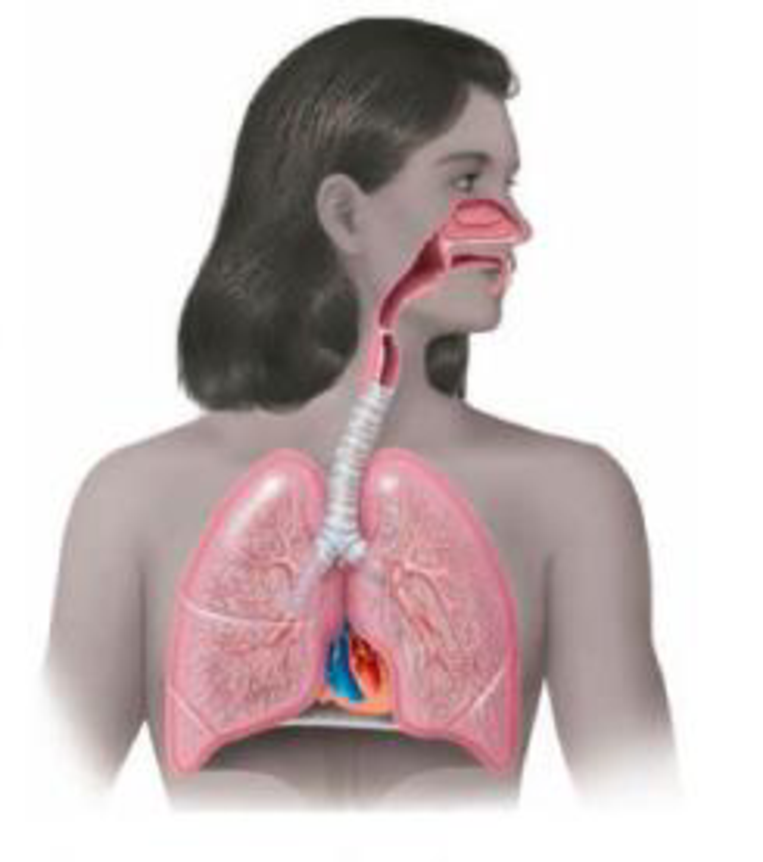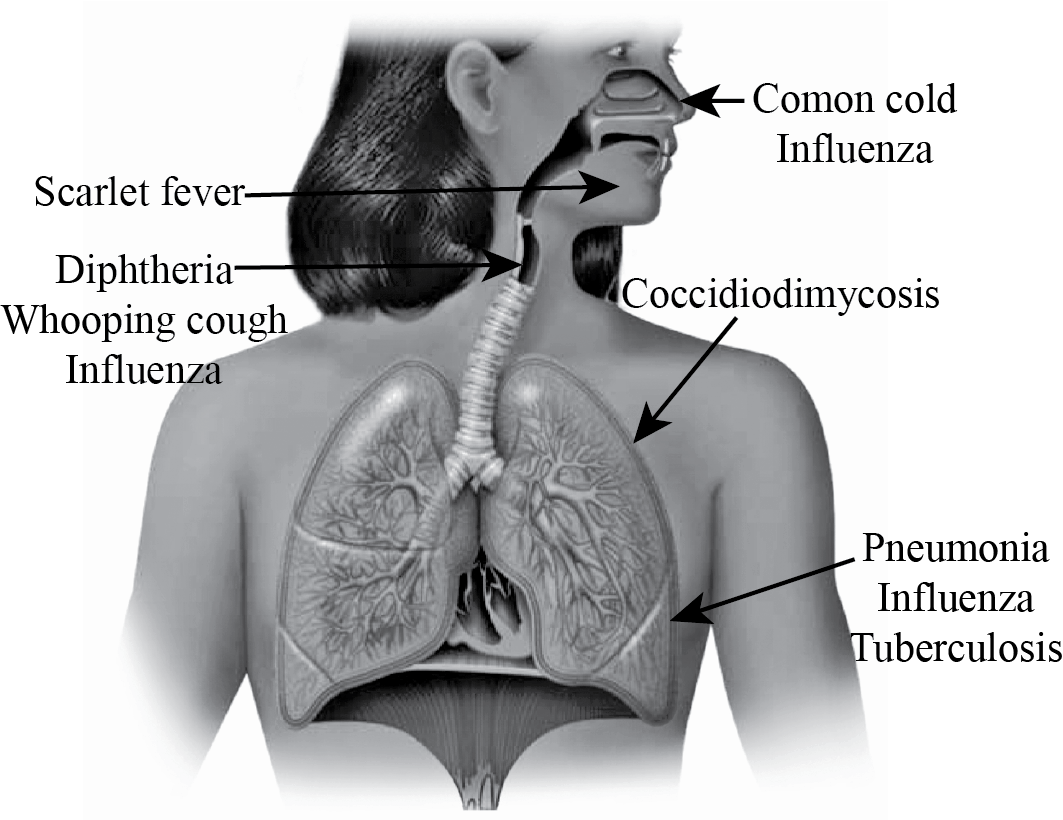
DRAW IT Show the locations of the following diseases: common cold, diphtheria, coccidioidomycosis, influenza, pneumonia, scarlet fever, tuberculosis, whooping cough

To determine:
The location of following diseases of common cold, diphtheria, coccidioidomycosis, influenza, pneumonia, scarlet fever, tuberculosis and whooping cough.
Concept introduction:
Respiratory system consists of two parts, lower and upper parts. Bacteria and virus affects both the parts but lower parts may affects highly than upper parts.
Explanation of Solution
Diagram:
Diseases of Respiratory system

Respiratory system causes diseases which are affected by both bacteria and virus. The upper part causes disease like common cold, diphtheria and whooping cough. Common cold is a viral infection of the upper respiratory system. It is caused by rhinovirus and coronavirus. Scarlet fever caused by streptococcal exotoxin, affects the skin by reddening of tongue and peeling of affected skin. Diphtheria caused by Corynebacterium diphtheria, causes sore throat and swelling of neck. Whooping cough is another disease caused by Bordetella pertussis, tracheal cytotoxin. It affects the cilia and damages the respiratory passages.
Pneumonia causes lower respiratory infection and leads to same symptoms as cold, cough, headache and fatigue and so forth. Pneumonia is the disease of the lower respiratory system. Influenza is characterized by fever, chills, muscular aches and headache. Mycobacterium tuberculosis is a gram positive, rod and an obligate aerobe that causes tuberculosis. It is also a lower respiratory infection.
Many virus can enter into our respiratory system although there is a constant inhibition of pathogens by cilia and mucous membrane. Mostly the upper part is affected but only the lower part is affected by virus infection.
Want to see more full solutions like this?
Chapter 24 Solutions
Microbiology: An Introduction, Global Edition
Additional Science Textbook Solutions
Campbell Biology (11th Edition)
Genetics: Analysis and Principles
Anatomy & Physiology: The Unity of Form and Function
Campbell Biology (10th Edition)
Human Biology: Concepts and Current Issues (8th Edition)
- Describe each of the following infections using correct technicalterminology. (Descriptions may fit more than one category.) Useterms such as primary, secondary, nosocomial, STD, mixed, latent,toxemia, chronic, zoonotic, asymptomatic, local, systemic, -itis, -emia.Caused by needlestick in dental officePneumocystis pneumonia in AIDS patientBubonic plague from rat flea biteDiphtheriaUndiagnosed chlamydiosisAcute necrotizing gingivitisSyphilis of long durationLarge numbers of gram-negative rods in the bloodA boil on the back of the neckAn inflammation of the meningesarrow_forwardWhich of the following organisms is the causative agent for a venereal disease? Yersinia pestis Treponema pallidum Leptospira interrogans Klebsiella pneumoniaearrow_forwardTJ Porter was a 15 year old high school student with a new summer job working with a gardening crew. His main job activity was spreading bark mulch in garden beds. Last August he rapidly developed severe shortness of breath, a persistent cough, and chest pains. On admittance to the hospital, radiological examination revealed large “cotton ball” densities in both of his lungs. Culture of his lung aspirate grew Aspergillus fumigatus. TJ was given IV amphotericin B and assisted mechanical ventilation via a tracheotomy. He slowly improved in the hospital, but also contracted 2 other respiratory infections with Pseudomonas aeruginosa and Strep. faecalis. These infections were treated with appropriate antibiotics.TJ had 4 sisters and 2 brothers. One of his brothers had a perirectal abscess in infancy but otherwise has been well.TJ’s white blood cell count was in the normal range, with ~65% neutrophils, 30% lymphocytes, and ~5% monocytes. Serum IgG and IgM levels were in the normal-to-high…arrow_forward
- What are the pathogens that would likely cause the mentioned diseases? Provide its morphology. Tuberculosis Actinomycosis Mycoplasma pneumoniaarrow_forwardAll statements are TRUE for psittacosis EXCEPT: Acquired from infected parrots AOTA Moderately easy to transmit NOTA Caused by Chlamydia psitacci Category A Biological agentsarrow_forwardWrite a paragraph about the disease caused by the tuberculosis bacillusarrow_forward
- Complete the table providedarrow_forwardThe parents of a 3-day-old male neonate are concerned by their child's condition. The child is irritable, has fever and blisters over most of his body, and peeling skin as seen in the attached image. Which of the following virulence factors produced by the most likely causal agent is responsible for this condition? Answers A - E A Alpha-Toxin B Beta hemolysin C Exfoliative toxin D Pyrogenic exotoxin E Toxic shock syndrome toxin O Question #6 attachment O .0arrow_forwardDiscuss the portal of exit of Mycobacterium tuberculosis from the human body or explain why there is not a portal of exitarrow_forward
- Which of the following pathogens mimic the host bilayer for transmission through the plasma membrane of human respiratory tract epithelial cells? Streptococcus pneumoinae O Legionella pneumophila O Mycoplasma pneumoniaearrow_forwardExplain why people in certain occupations are at increased risk ofbecoming infected with Erysipelothrix rhusiopathiae.arrow_forwardDoes the causative agent of tuberculosis, Mycobacterium tuberculosis, form spores thus making it very difficult to control? YES, it sporulates NO, it does not sporulatearrow_forward
 Comprehensive Medical Assisting: Administrative a...NursingISBN:9781305964792Author:Wilburta Q. Lindh, Carol D. Tamparo, Barbara M. Dahl, Julie Morris, Cindy CorreaPublisher:Cengage Learning
Comprehensive Medical Assisting: Administrative a...NursingISBN:9781305964792Author:Wilburta Q. Lindh, Carol D. Tamparo, Barbara M. Dahl, Julie Morris, Cindy CorreaPublisher:Cengage Learning Medical Terminology for Health Professions, Spira...Health & NutritionISBN:9781305634350Author:Ann Ehrlich, Carol L. Schroeder, Laura Ehrlich, Katrina A. SchroederPublisher:Cengage Learning
Medical Terminology for Health Professions, Spira...Health & NutritionISBN:9781305634350Author:Ann Ehrlich, Carol L. Schroeder, Laura Ehrlich, Katrina A. SchroederPublisher:Cengage Learning Microbiology for Surgical Technologists (MindTap ...BiologyISBN:9781111306663Author:Margaret Rodriguez, Paul PricePublisher:Cengage Learning
Microbiology for Surgical Technologists (MindTap ...BiologyISBN:9781111306663Author:Margaret Rodriguez, Paul PricePublisher:Cengage Learning





